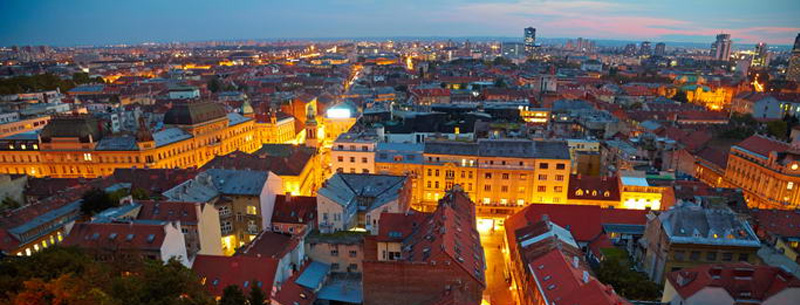Zagreb, capital city of Croatia
Zagreb combines vibrant, modern energy with plenty of old-world charm and graciousness. The town center is full of elegant Austro-Hungarian buildings housing fashionable boutiques, renowned restaurants, rowdy pubs, and scruffy beer halls. Nearby galleries show off local masterpieces, the concert halls host international stars and the latest sounds spun by DJs echo out onto the cobbled streets from crowded clubs. The city also appeals to nature-lovers with its refreshing stretches of open green spaces, nearby lakes and many outdoor cafes.
Art lovers have much to enjoy and explore in Zagreb. The Mimara Museum is the capital’s crowning jewel named after a private collector who generously left thousands of priceless objects to his native city. The extensive collection encompasses many time periods and regions, beginning with over 200 relics from ancient Persia, Egypt, Rome, Mesopotamia and Greece. The museum also boasts a number of paintings by international masters like Goya, Caravaggio, Raphael, Veronese, Degas, Renoir, Manet, Delacroix, Rubens, de la Tour and others.
The newest and largest museum in Croatia is the Museum of Contemporary Art, known to locals as MSU. The large collection was once crammed into a small space in Zagreb’s historic district but was moved in late 2009 to a modern, eye-catching building designed by Igor Franic. The permanent collection, called ìThe Collection in Motion,î features over 600 works by some of Croatia’s most edgy artists. Every three months, temporary exhibits open in the museum, often featuring international artists. The cultural hotspot also sponsors films, theater performances and concerts throughout the year.
History buffs will also find many sights of interest in the city. The Gradec Stone Gate is the only surviving medieval fortification in Zagreb today. The site became a shrine in 1731 after a fire destroyed every inch of the wooden gate but spared a painting of the Virgin and Child. Locals regularly pray at the site and leave flowers, believing the painting has miraculous powers. The western side of the gate is dominated by a statue of Dora, the revered heroine of an 18th-century Croatian novel. The real Dora lived just next door to the gate with her father.
One of the most emblematic buildings in the capital is St. Mark’s Church. The colorful example of late Gothic and Romanesque architecture dates back to the 13th century and features an incredible portal with 15 carved figures sitting in shallow niches. The interior is dotted with sculptures by local master Mestrovic, and the beautiful tiled roof features the medieval coats of arms of Slavonia, Croatia and Dalmatia.
The twin spires of the Cathedral of the Assumption of the Blessed Virgin Mary soar over the city. Built in the late 13th century, the cathedral is modeled after St. Urban’s Church in Troyes, France but retains a distinctly Croatian feel. The original Gothic structure has been renovated and transformed many times, but the sacristy still features wonderfully-preserved 13th-century frescoes. The interior is truly dazzling with its baroque marble altars, stone statues, ornate pulpit and side altar decorated with a triptych by celebrated artist Albrecht Durer.
Other must-see sights in the Croatian capital include the medieval Upper Town, the pristine Maksimir Park, the Zagreb Zoo, Lake Jarun, the huge Archaeological Museum, the Mirogoj Cemetery, the imposing Medvedgrad fortress and the Museum of Broken Relationships. Hailed a Europe’s most innovative museum in 2011, the permanent display showcases the leftovers that remain after a breakup.
Zagreb Geographical Location
Zagreb is located in the northwest of Croatia on the Sava River. It is the largest city of Croatia with 1,110,000 inhabitants.
Zagreb Language
Croatian is the official language of Croatia with a small percentage speaking Serbian, Italian, Hungarian, Czech, Slovak, or German. The vast majority of Croatians speak a foreign language in addition to Croatian, English being the most popular.
Zagreb Predominant Religion
- 88% Roman Catholic
- 4% Orthodox Christian
- 5% None
- 3% Other
Those who are not Roman Catholic or Orthodox Christian are primarily Muslim or another form of Christian.
Zagreb Currency
The Kuna is the official currency of Croatia.
Zagreb Climate
The summers are normally very pleasant in Zagreb without getting too hot and the summers are cold with several days of snow. June is the rainiest season although it does rain throughout the year regularly.
Zagreb Main Attractions
- Mirogoj Cemetery
- Cathedral of the Assumption
- Museum of Broken Relationships
Other Attraction in Zagreb
- Medvednica Mountain
- St Mark’s Church
- Zagreb Municipal Museum
- Jelacic Square
